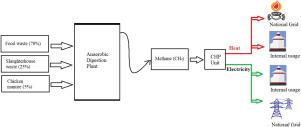当前位置:
X-MOL 学术
›
Energy Rep.
›
论文详情
Our official English website, www.x-mol.net, welcomes your feedback! (Note: you will need to create a separate account there.)
Technical-economical analysis of anaerobic digestion process to produce clean energy
Energy Reports ( IF 5.2 ) Pub Date : 2020-12-21 , DOI: 10.1016/j.egyr.2020.12.024 T.H. Chowdhury
Energy Reports ( IF 5.2 ) Pub Date : 2020-12-21 , DOI: 10.1016/j.egyr.2020.12.024 T.H. Chowdhury

|
Anaerobic digestion is an effective way to not only digest waste efficiently but also good amount of remunerable energy can be recovered without any significant carbon emission. In many countries landfill or incineration are still the main techniques for disposing waste in which their environmental viabilities remains in question. Anaerobic digestion (AD) process can provide a significant solution to a growing issue of organic garbage and simultaneously can fulfill the additional energy requirement. The main objective of this paper is to study the feasibility of anaerobic digestion plant for mixture of various types of wastages. The feedstock or organic waste for the analysis has been considered wastes from university/hotel, wastes of slaughterhouse and manure from poultry farm. This study offers a critical and comprehensive analysis of technical aspects of anaerobic digestion for different varieties of solid waste to produce electricity and heat. The prospective annual methane yield has been found 1,090,800 m from 40000 tonnes wastes. The estimated amount of heat is 19536 MJ/year along with electricity can be produced around 4824 MWh/year through combined heat and power (CHP). Beside producing clean energy from waste, the economic analysis and payback period (5.4 year) also indicates that the project can be a viable alternative to achieve UN’s Sustainable Development Goal (SDG) of affordable and green energy by 2030.
中文翻译:

厌氧消化生产清洁能源的技术经济分析
厌氧消化是一种有效的方法,不仅可以有效地消化废物,而且可以回收大量可再生能源,而不会产生任何显着的碳排放。在许多国家,填埋或焚烧仍然是处理废物的主要技术,但其环境可行性仍然存在问题。厌氧消化(AD)过程可以为日益严重的有机垃圾问题提供重要的解决方案,同时可以满足额外的能源需求。本文的主要目的是研究厌氧消化装置处理各类废物混合物的可行性。用于分析的原料或有机废物被认为是大学/酒店的废物、屠宰场的废物和家禽养殖场的粪便。这项研究对不同种类的固体废物厌氧消化产生电力和热量的技术方面进行了批判性和全面的分析。预计年甲烷产量为 1,090,800 m,来自 40,000 吨废物。估计热量为 19536 兆焦/年,通过热电联产 (CHP) 每年可产生约 4824 兆瓦时的电力。除了利用废物生产清洁能源外,经济分析和投资回收期(5.4 年)还表明,该项目可以成为到 2030 年实现联合国可持续发展目标(SDG)负担得起的绿色能源的可行替代方案。
更新日期:2020-12-21
中文翻译:

厌氧消化生产清洁能源的技术经济分析
厌氧消化是一种有效的方法,不仅可以有效地消化废物,而且可以回收大量可再生能源,而不会产生任何显着的碳排放。在许多国家,填埋或焚烧仍然是处理废物的主要技术,但其环境可行性仍然存在问题。厌氧消化(AD)过程可以为日益严重的有机垃圾问题提供重要的解决方案,同时可以满足额外的能源需求。本文的主要目的是研究厌氧消化装置处理各类废物混合物的可行性。用于分析的原料或有机废物被认为是大学/酒店的废物、屠宰场的废物和家禽养殖场的粪便。这项研究对不同种类的固体废物厌氧消化产生电力和热量的技术方面进行了批判性和全面的分析。预计年甲烷产量为 1,090,800 m,来自 40,000 吨废物。估计热量为 19536 兆焦/年,通过热电联产 (CHP) 每年可产生约 4824 兆瓦时的电力。除了利用废物生产清洁能源外,经济分析和投资回收期(5.4 年)还表明,该项目可以成为到 2030 年实现联合国可持续发展目标(SDG)负担得起的绿色能源的可行替代方案。


























 京公网安备 11010802027423号
京公网安备 11010802027423号